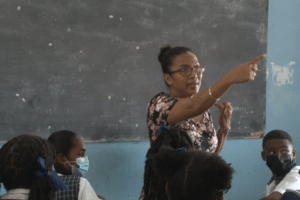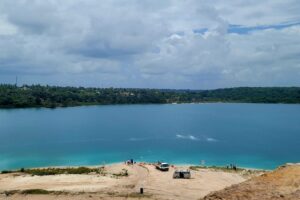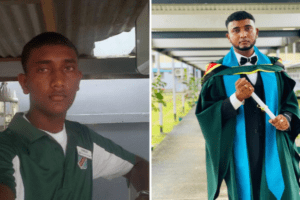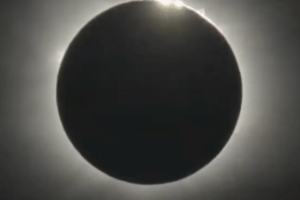If you heard about Guyana it means you would probably know of the mighty Essequibo River. On one of its many tributaries, the Potaro River, can be found the world-famous and magnificent Kaieteur Falls. Allow me to refresh your memory. Kaieteur Falls is the largest single-drop waterfall in the world. At the falls, the Potaro River plummets downwards a height of about two hundred twenty-six (226) metres in a single drop. The width of Kaieteur Falls is one hundred thirteen (113) metres. This coffee coloured water pours into a gorge below the waterfall in sprays of mists. With an average of 23,400 cubic feet of water pouring over the edge every second, Kaieteur Falls is one of the most powerful waterfalls in the world. It is one of Guyana’s main tourist hotspot.
The word Kaieteur means Old Man’s Falls, referring to the fall of Kai, a Touchau (Toshao) of the Patamona people, over the waterfalls. Most of us have heard of the Kaieteur News newspaper. We know that the name is derived from the Kaieteur Falls but have you wondered where or how the famous Kaieteur Falls got its name? Well, you are in luck. Continue reading and hopefully, you leave knowing a little bit more about the origin story of Kaieteur Falls.
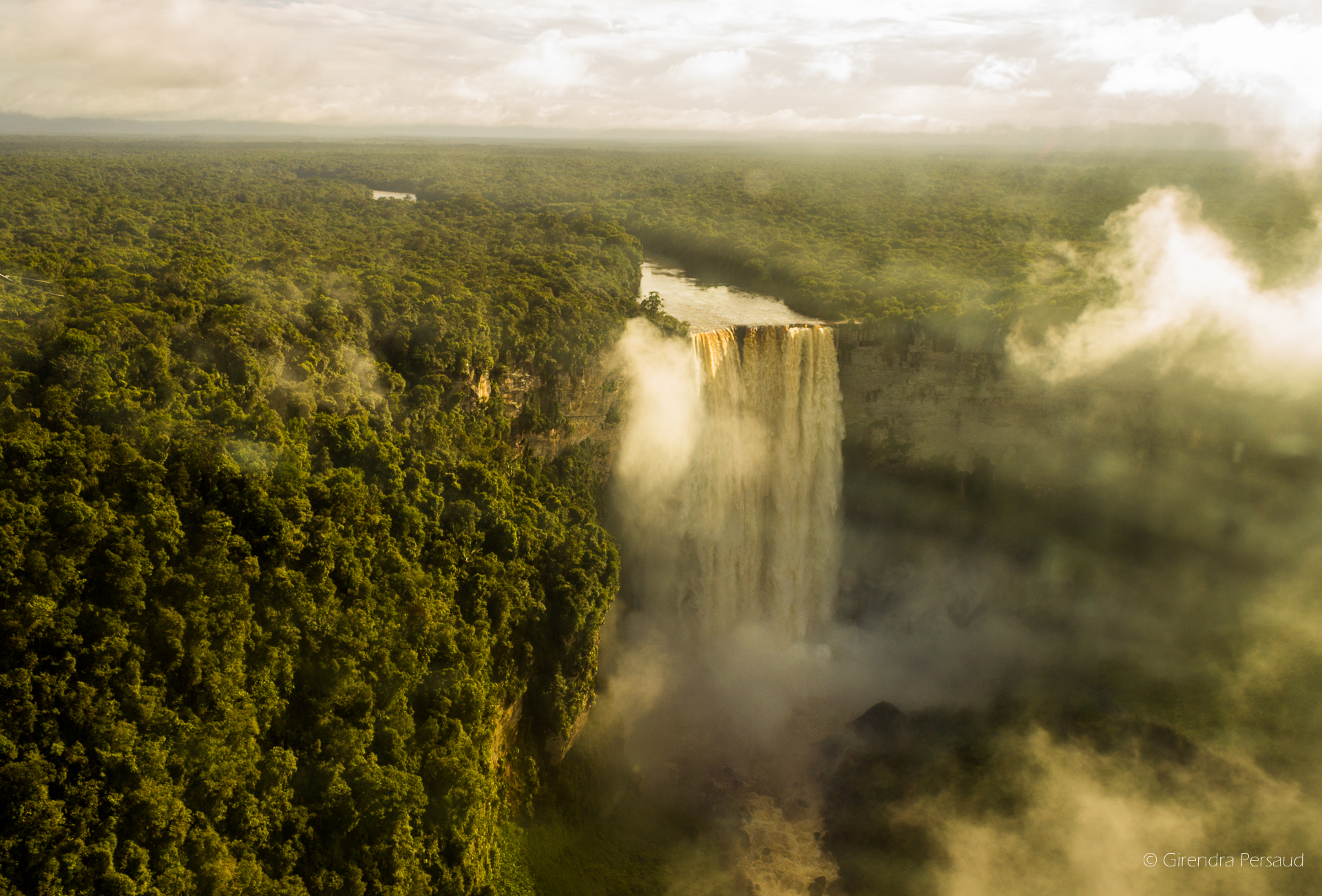
Kaieteur Falls
Who is Kai?
The Kaieteur Falls was named after Kai. The most popular tale of Kai tells us of the Chenau village chief or Touchau (Toshao). Kai was a Patamona, one of the nine tribes of Indigenous people who came to Guyana. Kai wore a tall, colourful headdress made of feathers of the rarest birds. A piece of animal hide covered his loin. He was brown-skinned, short and muscular, like many of our Indigenous people.
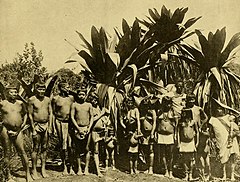
The Patamona People – Photo by https://www.revolvy.com/page/Patamona-people
The Story of Old Kai
Many years ago before the Kaieteur Falls was named, there lived a peaceful tribe of the Patamonas on the Potaro. The Patamonas called themselves the Kapon. Their descendants live there to this day. They are protectors of the sacred falls and life around it. This tribe of people lived along the waterway of the Pakaraima Mountains in a village called Chenau.
Not very far away lived a warrish tribe of Caribisi, commonly known as Caribs. The Caribs were a ferocious set of Amerindians. They fought among themselves to prove bravery. The Caribs fought to win the domination of other tribes as a show of power. The Patamonas of Chenau were no exception to this sick power battle. The Caribs regularly raided and tormented the village of Chenau. The Patamonas farmed cassava, corn, vegetables, and sweet potatoes. Caribs would raid Chenau and carry off the women and food grown by the Patamonas.
After being steadily attacked by the Caribs, the village chief at the time, Kai, sought for a peaceful way out. He prayed humbly to the Makonaima, the Great Spirit of their people. This Great Spirit does not have a physical form and is never seen by mortal man. Makonaima spoke to Kai and he listened. One day in an act of self-sacrifice, Kai took his wooden canoe and paddled faithfully over the waterfall. This was done in exchange for the protection of his tribe. He selflessly gave up his life in exchange for peace, rather than start a war between the tribes. This is proof in itself of how harmonious and peace-loving the Patamonas were. It is said that Kai’s canoe lies at the bottom of this great falls and has been turned to stone.
The Kaieteur Falls is named after this brave village chief, Kai. The falls is also referred to as Kayik Tuwuk or Old Man Falls in the Patamona language. Descendants of Kai and his tribe live on the Potaro River, guiding travelers and protecting the life around Kaieteur Falls.
Fun Facts:
- Chenau was named after the mountain chicken found in these parts which are used for food. Mountain Chicken is nothing like the local birds we eat. Mountain chickens are really frogs, said to taste like chicken.
- The Caribbean was named after the Caribs.
- When translated, Makonaima means “He Works By Night.”
- Kai is the name of the village chief and “teur” is translated to the word falls. Combined, we get Kaieteur.
Visit Kaieteur Falls and decide if it really is Kai’s canoe, stuck at the bottom of this majestic waterfall. To experience the grandeur of the Kaieteur Falls there are several agencies in Guyana that offer Kaieteur tours. The cost of these tours starts at about $215 USD per person. Contact one of the following tour agents and book your tour now.
Evergreen Adventures
- Address: Trans Guyana Airways Building Eugene. F. Correia International Airport, Ogle, East Coast Demerara
- Telephone #: (592) 222-2525, 222- 8053, 222-0264
- Email: [email protected]
Air Services Limited
- Address: EFC International Airport, Ogle, East Coast Demerara
- Telephone #: (592) 222-1234, (592) 222-433, (592) 222-2536 or (592) 222-4368
- Email: [email protected]
Air Guyana
- Address: Ogle East Coast Demerara, Guyana
- Telephone #:(592) 222 6513
- Email: [email protected] or [email protected]
Old Forts Tours
- Address: Tower Suites Inc., Georgetown, Guyana
- Telephone #:(592) 225-1035, (592) 225-1037 or 954-531-5089
- Email: [email protected]
Rainforest Tours
They are the people to contact if you are interested in an overland tour to Kaieteur Falls (Perhaps then you can really get to look for Kai’s canoe). According to their website “Are you adventurous and like to try something new? Then this exciting five-day overland tour to Kaieteur is packed with all the adventure you’ll need! It’s rugged, wet, wild and filled with exciting challenges plus breathtaking scenery.”
The offer:
- Professional Tour Guide
- Jungle Hiking (Mild to Ruff Terrain)
- Breakfast, Lunch, Dinner & Snacks
- Outdoor Camping
- Trail Driving & Speed Boat Transport
- Flora, Fauna & Wildlife.
See more details of Rainforest Tours here: http://www.rftoursgy.com/Tours_Overland_Tours.html
- Address: 5 Ave of the Republic, Georgetown, Guyana (Upstairs Of Churches Chicken)
- Office Main: (592) 231-5661
- Mobile: (592) 624-3298
Also, see another article “Kaieteur Falls Is The World’s Largest Single Drop Waterfall By Volume” for more details.
Article References:
- https://www.ibike.org/ibike/guyana/essay/2-Kaieteur.htm
- https://moipa.gov.gy/amerindian-nations/
- http://www.bigorrin.org/carib_kids.htm
- https://www.guyanatourism.com/kaieteur-an-untamed-beauty-steeped-in-legends-and-folklore/
- https://www.world-of-waterfalls.com/waterfalls/latin-america-kaieteur-falls/
- https://myturntotravel.com/kaieteur-falls-guyana/

